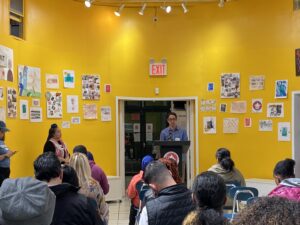In July, the MTA announced that one in six transit rides fares were paid using the OMNY system. OMNY (One Metro New York) is the Metropolitan Transportation Authority’s (MTA) new contactless payment option, which is set to fully replace MetroCards in 2023. There are a few options for using OMNY – smart phone payments, contactless credit and debit cards, and pre-paid OMNY cards which will be sold by retailers around the city as well as through in-station vending machines, which have yet to be installed. While the MTA touts the seamless nature of the new OMNY system, pointing to how payments can be made through devices and cards many riders already have, serious concerns about equity and privacy exist.
Who has access to OMNY?
Ad campaigns for OMNY have become a mainstay in most subway cars and buses in recent months, with their simple icons showing how easy it is to pay for your ride using your smart phone, smart watch, or credit or debit card. While smart phone ownership is on the rise across the country, it is not yet universal–only 61% of adults over 65, 75% of those with a high school education or less, and 76% of households earning less than $30,000/year say they own a smart phone according to recent research by the Pew Charitable Trust. OMNY is also accessible with other tools, namely credit and debit cards that allow contactless payments.
For the 11.2% of New York families without bank accounts, the payment options described above may come with hurdles. Prepaid payment cards are a viable option for people without bank accounts, but they can include a host of fees that can burden already vulnerable populations. Cash payments would ensure that everyone can pay for a ride, regardless of technology use or banking status. According to a press release from the MTA celebrating 100 million OMNY taps, “purchasing your fare with cash will always be an option.” How exactly this will work remains to be seen though–cash payments are currently suspended at station booths and OMNY vending machines have not yet reached stations.
Who does OMNY benefit?
Another major question surrounding the OMNY roll-out is how the massive amounts of data the system can amass will be used and protected. The OMNY system has the potential to tap into a huge amount of personal user data and the terms of service do not explicitly state how this information can be used, or even what information will be collected. Each smart device, credit, or debit card tapped is a data point.
MetroCards are also trackable, and privacy experts have raised concerns about how law enforcement agencies and the MTA can access minute details about riders’ habits and whereabouts. But the potential for data collection from personal phones and other smart devices far exceeds this.
Why aren’t more people using OMNY?
The MTA has a long way to go to achieve a wholesale switch to the OMNY system. The barriers outlined above may explain why some have yet to make the switch. For New Yorkers with access to both bank accounts and smartphones though, other reasons for hesitancy are at play. One factor may be that OMNY does not yet offer weekly or monthly passes or pre-tax payment options. Many transit riders receive MetroCards through their work and have little incentive to make the switch to OMNY when the system does not accommodate these benefits.
Another reason could be that, as with any habit change, it just takes time. MetroCards have been an intrinsic part of life in New York City for over two decades, and in many ways are a part of the city’s image. OMNY is a more universal and anonymous system, which could cause some to drag their feet and cling to the MetroCard.
What should be done to ensure all communities benefit?
The MTA could work with the city to make OMNY more seamless and attractive. One strategy is to use OMNY to connect all public transportation options in the city, i.e., subway, bus, Citi Bike, and NYC ferries. Streamlining payments across these different services would encourage more rapid uptake. Providing for transfers across these systems would also benefit riders who live in transit deserts and must rely on multiple services (for example, Citi Bike to bus) to move through the city.
The MTA should also work to quickly rollout the prepaid payment cards it has promised. For riders who are either unable or unwilling to use smartphones or contactless debit or credit cards at turnstiles, the prepaid cards would ensure access while providing a sense of continuity from the current system. Cash payment options also need to be quickly installed across the system to ensure that riders who rely on cash for their purchases have the time to adapt and are not left out of the transition.





 Public Works Partners is a WBE/DBE-certified urban planning and consulting firm. Our expertise lies in creating innovative, equitable, and sustainable solutions to complex problems.
Public Works Partners is a WBE/DBE-certified urban planning and consulting firm. Our expertise lies in creating innovative, equitable, and sustainable solutions to complex problems.